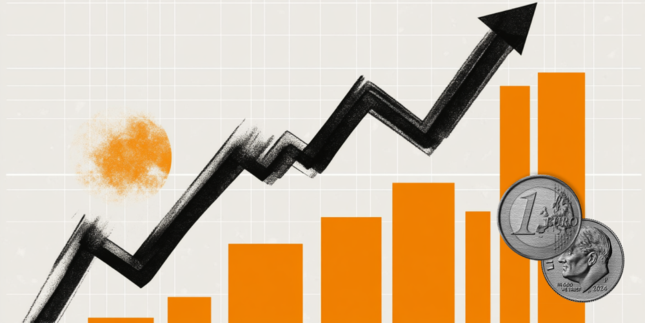Outlook: We are not sure the yield on the 10-year note has bottomed. It’s off the worst level but hardly back to the pre-Fed high around 2.60% or the high last December at 2.639%. The WSJ says “The 10-year Treasury yield was headed for the first quarterly decline in three quar-ters. It was 2.446% at the end of 2016.” What does it say if Q1 this year ends with a lower yield than the year before? It can mean demand for the safe-haven asset is far higher, or it can mean inflation expecta-tions have fallen sharply, or both.
So far today the yield is slipping downward, to 2.376% at 7:40 am ET from 2.389% at 8:25 pm last evening and 2.413% at the open yesterday. See the Market Watch chart. Is that a double top? The neck-line low is 2.314% from Feb 24. We are not that far from it now.
The dollar doesn’t move one-for-one with the yield, but the general correlation is not to be neglected. We expect a dollar pullback to be more long-lasting than two days. If the yield keeps sliding down, it would have to be outmatched by a slide in the Bund yield for the dollar just to stay in place. That’s an oversimplified way to put it, but not inaccurate.
Back on the geopolitical front, the WSJ has a front-page story summarized like this: “The Trump ad-ministration is signaling to Congress it will seek mostly modest changes to Nafta in upcoming negotia-tions with Mexico and Canada despite President Trump having called the trade deal a ‘disaster’ during the campaign.” Trump’s crude “negotiating” tactic—beat them over the head with a baseball bat and then make nice—is developing as expected. This is dimly dollar-favorable.
Not so favorable is the dollar vs. the pound, despite uncertainty about what comes next in Brexit. You wouldn’t know anyone has any worries looking at sterling, which has recovered the high this morning from two days ago at 1.2478 and looks like running away. Traders are having a ball putting the short squeeze on the skeptics.
PM May’s letter yesterday to European Council Pres Tusk was reproduced everywhere. Some say it sounds conciliatory. It’s certainly not hostile. It’s also very long and includes two conditions that stand out—“We should engage with one another constructively and respectfully, in a spirit of sincere cooper-ation.” and “We should always put our citizens first.” There’s the financial center in London. There’s the Irish issue. There’s security and defense. The UK does have an advantage there, having actually spent the money and the effort (unlike the Continent). Europe needs these things and more from the UK. PM May emphasized that trade and security are trade-offs and here the UK has a couple of aces.
For its part, the EU lead negotiator, Michel Barnier, responded with a 3-part schedule. The exit will take 18 months, from June 2017 to late October 2018. Here’s the problem—the first part has to be agreed before moving on the second part. The FT reports the three topics are “disentangling past ties and commitments; setting goals for future relations, and arranging transition terms to avoid unneces-sary disruption.” The FT has a list of the “expected sticking points” at each stage. We are not alone in wondering whether Northern Ireland will not be the sticking point that can’t be greased over.
To return to the yield/inflation story, we continue to think that the oil price symbolizes inflation to many, and it’s more than a symbol—oil prices permeate every corner of every economy. We get the personal consumption expenditures and the accompanying PCE price index tomorrow. But what is the longer-term forecast? Below is the Fed’s forecast. It looks okay, right? Yields should track it and be on the rise, too. Well, maybe. Maybe a slip and all that. We must assume oil prices are embedded in the PCE price index forecast. But what is the Fed’s forecast? If the Fed’s inflation forecast relies on rising oil prices, it may be wrong.
Oil prices are confusing. Yesterday Brent spiked to a high of $52.54 and WTI to $49.51, up 2.4% on the day, after the EAI reported the inventory build was not as high as forecast—even though the cumu-lative amount hit an all-time high, 534 million from 533.1 million the week before. The EIA had a gain of 900,000 barrels after the API had 1.91 million. But inventories of gasoline and distillates fell more than forecast. Meanwhile, OPEC will meet May 25 to decide whether to keep output down by 1.2 mil-lion bpd for the second half of the year. They are likely to agree, but it doesn’t pass the “So What?” test, since the US is exporting over 1 million bpd, the highest since 1958. The WSJ reports “The U.S. is exporting more oil than five of the Organization of the Petroleum Exporting Countries’ 13 members. Of course the U.S. still imports oil (for now), but net imports have declined by half.” Besides, shale production keeps getting more efficient by the minute (and without IT and software, just old-fashioned engineering). Shale output is the highest in 13 months at over 9.1 million bpd.
So, we have confusion about the direction of yields. We have confusion about inflation and especially inflation predicated on rising oil prices, which may not happen. We have confusion about Brexit, which is supposed to wreck the UK economy but not before traders squeeze the impulse to short sterling out of the minds of Big Picture traders. We have confusion about what the Trump gang is doing and why, with a heavy dose of suspicion that they are just winging it and have no long game at all. It seems clear that there is something really very bad going on in the Russian connection and Trump should probably end up like Nixon, but Trump is delaying disclosure with the collusion of some in Congress, itself en-gendering the checks and balances concept. And the US runs out of federal budget in about a month.
Offsetting the Trump trainwreck, a little, is worry about the survival of the EU. The advent of Trump makes some think LePen is next. The advent of Brexit emboldens some to imagine Frexit will be next. Yesterday LePen showed up in Moscow and by now everyone knows Russia seeks to dismantle the EU and NATO as well as discredit American democratic processes.
Granted, these developments are scary, but still don’t go very high in the probability rankings. We lived in France. Three observations: “bourgeois” is not a dirty word, as the lefties (and hippies) would have it, but rather a goal. After being bossed around by the Nazis, the French are not likely to choose getting bossed around by the Reds. And finally, the rampantly misogynist French are even less likely to elect a woman. Relax. If the EU or EMU has stress at the seams, it won’t rip open because of the French, whofamously do know which side of the bread their butter is on.
Where is the dollar going? We expect a pullback to last a little longer than two days but you never know. Watch that yield.
| Currency | Spot | Current Position | Signal Date | Signal Strength | Signal Rate | Gain/Loss |
| USD/JPY | 111.03 | SHORT USD | 03/21/17 | WEAK | 112.51 | 1.20% |
| GBP/USD | 1.2426 | LONG GBP | 03/22/17 | STRONG | 1.2465 | -0.23% |
| EUR/USD | 1.0738 | LONG EURO | 03/16/17 | WEAK | 1.0711 | 0.25% |
| EUR/JPY | 119.36 | SHORT EURO | 03/28/17 | WEAK | 120.19 | 0.69% |
| EUR/GBP | 0.8633 | LONG EURO | 03/02/17 | WEAK | 0.8575 | 0.68% |
| USD/CHF | 0.9964 | SHORT USD | 03/16/17 | WEAK | 0.9995 | 0.31% |
| USD/CAD | 1.3342 | SHORT USD | 03/28/17 | WEAK | 1.3397 | 0.41% |
| NZD/USD | 0.7017 | LONG NZD | 03/28/17 | WEAK | 0.7022 | -0.07% |
| AUD/USD | 0.7673 | SHORT AUD | 03/28/17 | WEAK | 0.7607 | -0.87% |
| AUD/JPY | 85.29 | LONG AUD | 03/22/17 | STRONG | 85.20 | -0.11% |
| USD/MXN | 18.6907 | SHORT USD | 01/31/17 | WEAK | 20.8108 | 10.19% |
This morning FX briefing is an information service, not a trading system. All trade recommendations are included in the afternoon report.
Recommended Content
Editors’ Picks

EUR/USD stabilizes above 1.1350 on Easter Friday
EUR/USD enters a consolidation phase above 1.1350 on Friday as the trading action remains subdued, with major markets remaining closed in observance of the Easter Holiday. On Thursday, the European Central Bank (ECB) announced it cut key rates by 25 bps, as expected.

GBP/USD fluctuates below 1.3300, looks to post weekly gains
After setting a new multi-month high near 1.3300 earlier in the week, GBP/USD trades in a narrow band at around 1.32700 on Friday and remains on track to end the week in positive territory. Markets turn quiet on Friday as trading conditions thin out on Easter Holiday.

Gold ends week with impressive gains above $3,300
Gold retreated slightly from the all-time high it touched at $3,357 early Thursday but still gained more than 2% for the week after settling at $3,327. The uncertainty surrounding US-China trade relations caused markets to adopt a cautious stance, boosting safe-haven demand for Gold.

How SEC-Ripple case and ETF prospects could shape XRP’s future
Ripple consolidated above the pivotal $2.00 level while trading at $2.05 at the time of writing on Friday, reflecting neutral sentiment across the crypto market.

Future-proofing portfolios: A playbook for tariff and recession risks
It does seem like we will be talking tariffs for a while. And if tariffs stay — in some shape or form — even after negotiations, we’ll likely be talking about recession too. Higher input costs, persistent inflation, and tighter monetary policy are already weighing on global growth.

The Best brokers to trade EUR/USD
SPONSORED Discover the top brokers for trading EUR/USD in 2025. Our list features brokers with competitive spreads, fast execution, and powerful platforms. Whether you're a beginner or an expert, find the right partner to navigate the dynamic Forex market.